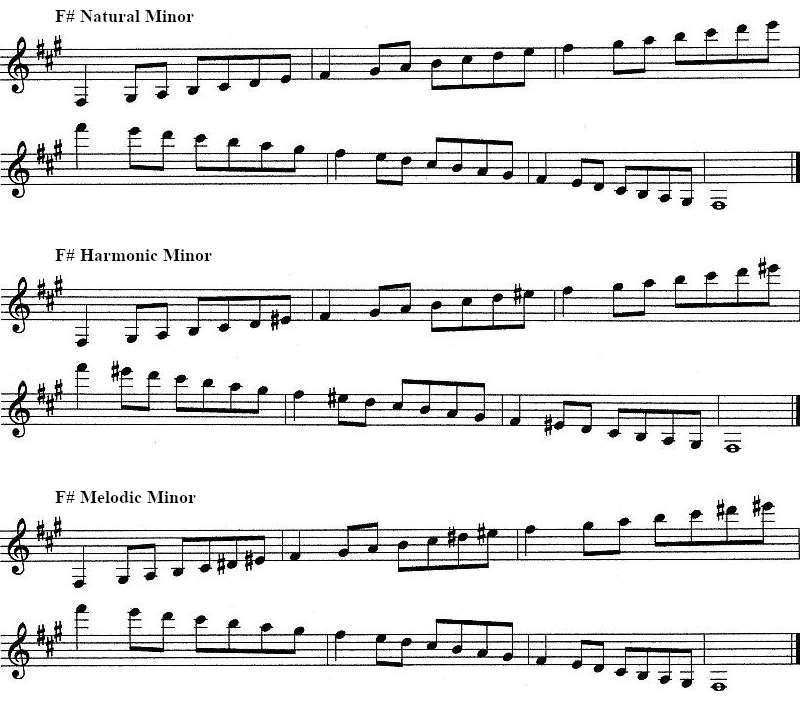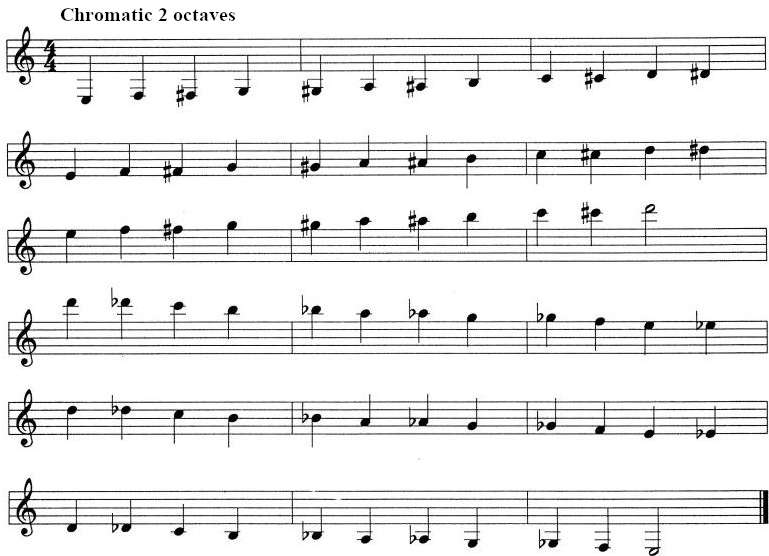
Learning to play scales is one of the most important ways for a beginning clarinetist to expand their skills. Scales will help you learn how to fluently play your instrument.
When I was a young clarinetist just starting out, I had no desire to learn to play scales. I wanted to learn to play familiar tunes on the clarinet. As I grew more experienced, I realized that scales were important to my learning process.
When I was a young player, it took me about six months to learn useful scales. I still play clarinet scales as part of my practice today, along with etudes (short study pieces) based on scales.
Here I’ll introduce clarinet scales and explain how playing them will make you a better musician. I’ll break down the process of learning a scale and list some of the most important scales for beginner players to learn.
Understanding clarinet scales
A scale is a sequence of notes that cover one or more octaves in a musical key. A scale has eight notes in each octave. An easy way to understand a scale is by remembering the song “Do Re Mi” from the film The Sound of Music (1965).
How important is learning scales for progressing with the clarinet?
Learning scales helps you understand how music is put together. Scales are one of the basic building blocks of practicing any instrument, including the clarinet. And all genres of music depend on scales.
You’ll find many passages in the music you learn become easier to play once you learn scales. Many melodies are based on scales, which you’ll discover as you start reading music. A scale teaches you which notes belong in a key.
Forgoing learning scales will make any instrument harder to learn. And if you don’t know your scales, you’ll feel lost when you play with a musical ensemble.
Advice for learning clarinet scales
Here are some tips and strategies that will make learning scales easier:
- Start by playing your scales on long tones like whole notes—hold the note for four beats. Speed up to a faster tempo as you get better at playing the scale.
- Progress gradually. Don’t push yourself to learn too quickly. Many new musicians can become frustrated and give up when they feel they’re not making enough progress.
- Be sure to equally practice going up and down the scale. Start with one octave and then progress to two and even three octaves as you get more experienced.
You should be able to play all your important scales quickly and fluently following consistent practice and these steps.
Printable clarinet scale sheets
We’ll be covering more than 20 different clarinet scales here. And although you may want to read about each one, it can be nice to review offline. You’re welcome to download the clarinet scale sheets and to refer to separately.
Clarinet major scales
Major scales make music sound optimistic and positive. They’re the basic type of scale that all musicians learn. They’re also the type of scale featured in the song “Do Re Mi” mentioned earlier. In a major scale, the ascending sequence goes whole step, whole step, half step, whole step, whole step, whole step, half step.
Imagining a piano keyboard may be helpful for visualizing how a major scale is constructed. When you play a C-major scale on the piano, you play all the white keys going up the scale from C to the next C above it.

Visualizing scales on the clarinet is less straightforward. But if you keep your scales in a lesson book, you’ll be able to keep track of them more easily.
The following scales are listed in order of difficulty, from easiest to hardest. Most beginning musicians start out with C major and gradually add sharps and flats as they learn to play. The hardest scales, mentioned near the end of the list, have as many as six or seven sharps or flats.
C major
C major is the easiest major
scale to learn because it has no sharps or flats. Most beginner clarinetists
learn this scale starting at middle C just below the staff and going up one
octave.
Clarinetists will find they have to go over the “break” between A and B natural
in order to complete the scale. This can be tricky and practicing it as much as
possible is essential when you’re just learning your instrument.

F major
The second scale most young clarinetists learn is F major. It has one flat, B-flat. The advantage of an F scale is you can start in the low register below the staff. This is one of the first scales where many young players become able to play a two-octave scale.

G major
G major has one sharp, F-sharp and is another relatively easy scale.

B-flat major
One of the most common scales used in the concert band repertoire is B-flat. It has two flats, E-flat and B-flat.

D major
D major has two sharps, C-sharp and F-sharp. It’s an important key and is most players’ introduction to C-sharp.

E-flat major
Here we begin to see more difficult scales as we move up to three flats. The flats in the E-flat major scale are E-flat, B-flat and A-flat. Flat scales are often found in clarinet music, so this key is a necessity.

A major
A major has three sharps: F sharp, C sharp and G sharp. It’s a less common key in band music but is still important to learn.

A-flat major
A-flat major has four flats: A-flat, B-flat, E-flat and D-flat. It’s a common key in band music, so clarinetists will be doing themselves a favor by becoming familiar with this scale.

E major
The key with four sharps is E major. It’s another uncommon key in the clarinet repertoire but is worth practicing anyway.

D-flat major
Things are challenging when a key has five flats. B-flat, E-flat, A-flat, D-flat and G-flat are all included in the D-flat major scale.

B major
Not to be outdone is the B-major scale with its five sharps. This scale has F-sharp, C-sharp, G-sharp, D-sharp and A-sharp. Fluency in one of these keys with five or more sharps or flats shows you’re becoming truly skilled with your instrument.

G-flat major
The G-flat major scale has six flats. They are B-flat, E-flat, A-flat, G-flat and C-flat. This is not a commonly used key on the clarinet, but it would not hurt to learn it anyway.

Clarinet minor scales
A minor scale is typically used in a piece of music to represent a sad or thoughtful mood.
Minor keys that have the same number of sharps or flats as a major key are known as relative keys. The first note of the relative minor scale is the sixth note of the major scale. For example, C major’s relative minor scale is A minor.
There are three different types of minor keys: the natural minor, the melodic minor and the harmonic minor. The three types of minor scales are important for understanding the structure of music. But they don’t often appear in the first few years of learning an instrument.
The natural minor uses only the notes in the relative major scale. For example, A natural minor contains only A, B, C, D, E, F, G and A. There are no other sharps or flats used in the scale.
The harmonic minor differs from the natural minor because it has a half-step between the seventh note of the scale and the resolution. This is known as a leading tone, which helps with the resolution of the chords. For example, there is a G sharp in the seventh position of the A harmonic minor scale.
A melodic minor is like a harmonic minor. When the scale is ascending, the leading tone on the seventh position is in place. When the scale is descending, it’s replaced by the G as in the natural minor.
These scales are arranged in order of difficulty, by the relative key (the key with the same number of sharps and flats).
A minor
A minor has no sharps and flats. It’s very common and an easy scale to learn.

D minor
Like its relative key, F, D minor has one flat, B-flat. This is another easy scale that novice clarinetists can learn right away.

E minor
E minor has one sharp, F-sharp.

G minor
Like B-flat major, G minor has two flats, B-flat and E-flat.

B minor
B minor has two sharps, F-sharp and C-sharp, like its relative key of D.

C minor
C minor has three flats like its relative key of E-flat.

F-sharp minor
F-sharp minor has three sharps like its relative key of A.

F minor
F minor has four flats like A-flat major.

C-sharp minor
C-sharp minor, the relative minor to E major, has four sharps.

Clarinet chromatic scale in two octaves and three octaves
A chromatic scale is comprised of half-steps. For example, a chromatic C scale includes C, C-sharp, D, E-flat, E, F, F-sharp, G, A-flat, A, B-flat, B and C.
Chromatic scales are one of the most important things you can learn on your clarinet. They’ll help you learn all the notes on your instrument. They’ll also help you learn alternate fingerings for certain notes.
For example, you can play F-sharp on the staff by using just your first finger on the top tone hole. You can also play it by using the regular fingering for F (thumb on the back tone hole) and pressing two of the side keys with your right hand.

Learning alternate fingerings will help you become more fluent with your instrument and make tricky passages easier.
Young players usually learn chromatic scales when they’ve been playing their instrument for a year or two. Two octaves are fine. But for even better mastery of your instrument, learn three octaves.

Conclusion
My number one tip for practicing scales is to play them as often as possible. Start slow and progress to a faster scale as you get better at it.
You can also get books of etudes (short practice pieces) based on scales. I recommend Melodious and Progressive Studies, Book 1 edited by David Hite.
Learning scales will make music easier to play and to understand. Though it may seem like a chore, you need to become familiar with scales to become a good clarinetist.
Thankyou very much. I took lessons and played the clarinet , studied hard from 8 years of age to 18. Then I joined the service, sold it and never played again.
Now I am 66 , picked it up, again, and loving it. Together with Tenor sax. What I realized I never did two very important things ( focus was classical)
1. Never learned scales
2. Never learned or practice hearing and playing.
I realize this was a big error but never tool late to learn. Your document helps me greatly,
Thanks!